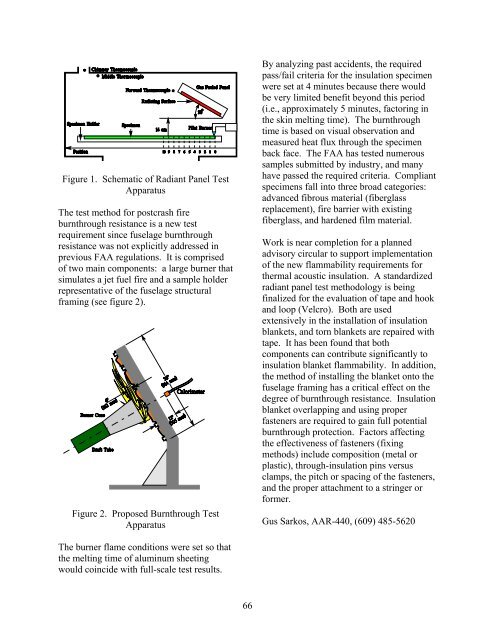AAR-400 Highlights 2002 - Fire Safety Branch - FAA
AAR-400 Highlights 2002 - Fire Safety Branch - FAA
AAR-400 Highlights 2002 - Fire Safety Branch - FAA
You also want an ePaper? Increase the reach of your titles
YUMPU automatically turns print PDFs into web optimized ePapers that Google loves.
Figure 1. Schematic of Radiant Panel Test<br />
Apparatus<br />
The test method for postcrash fire<br />
burnthrough resistance is a new test<br />
requirement since fuselage burnthrough<br />
resistance was not explicitly addressed in<br />
previous <strong>FAA</strong> regulations. It is comprised<br />
of two main components: a large burner that<br />
simulates a jet fuel fire and a sample holder<br />
representative of the fuselage structural<br />
framing (see figure 2).<br />
Figure 2. Proposed Burnthrough Test<br />
Apparatus<br />
The burner flame conditions were set so that<br />
the melting time of aluminum sheeting<br />
would coincide with full-scale test results.<br />
66<br />
By analyzing past accidents, the required<br />
pass/fail criteria for the insulation specimen<br />
were set at 4 minutes because there would<br />
be very limited benefit<br />
beyond this period<br />
(i.e.,<br />
approximately 5 minutes, factoring in<br />
the skin melting time). The burnthrough<br />
time is based on visual observation and<br />
measured heat flux through the specimen<br />
back face. The <strong>FAA</strong> has tested numerous<br />
samples submitted by industry, and many<br />
have passed the required criteria. Compliant<br />
specimens fall into three broad categories:<br />
advanced fibrous material (fiberglass<br />
replacement), fire barrier with existing<br />
fiberglass, and hardened film material.<br />
Work<br />
is near completion for a planned<br />
advisory circular to support implementation<br />
of the new flammability requirements for<br />
thermal<br />
acoustic insulation. A standardized<br />
radiant panel test methodology is being<br />
finalized for the evaluation of tape and hook<br />
and loop (Velcro). Both are used<br />
extensively in the installation of insulation<br />
blankets, and torn blankets are repaired with<br />
tape. It has been found that both<br />
components can contribute significantly to<br />
insulation blanket flammability. In addition,<br />
the method of installing the blanket onto the<br />
fuselage framing has a critical effect on the<br />
degree of burnthrough resistance. Insulation<br />
blanket overlapping and using proper<br />
fasteners are required to gain full potential<br />
burnthrough protection. Factors affecting<br />
the effectiveness of fasteners (fixing<br />
methods) include composition (metal or<br />
plastic), through-insulation pins versus<br />
clamps, the pitch or spacing of the fasteners,<br />
and the proper attachment to a stringer or<br />
former.<br />
Gus Sarkos, <strong>AAR</strong>-440, (609) 485-5620
















